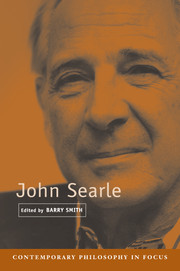Book contents
- Frontmatter
- Contents
- List of Contributors
- 1 John Searle: From Speech Acts to Social Reality
- 2 From Speech Acts to Speech Activity
- 3 Intentions, Promises, and Obligations
- 4 Law
- 5 Action
- 6 Consciousness
- 7 The Intentionality of Perception
- 8 Sense Data
- 9 The Limits of Expressibility
- 10 The Chinese Room Argument
- 11 Searle, Derrida, and the Ends of Phenomenology
- Further Reading
- Index
8 - Sense Data
Published online by Cambridge University Press: 05 June 2012
- Frontmatter
- Contents
- List of Contributors
- 1 John Searle: From Speech Acts to Social Reality
- 2 From Speech Acts to Speech Activity
- 3 Intentions, Promises, and Obligations
- 4 Law
- 5 Action
- 6 Consciousness
- 7 The Intentionality of Perception
- 8 Sense Data
- 9 The Limits of Expressibility
- 10 The Chinese Room Argument
- 11 Searle, Derrida, and the Ends of Phenomenology
- Further Reading
- Index
Summary
INTRODUCTION
(1) John Searle describes himself as a “naive realist” or a “direct realist,” so far as visual perception is concerned. The theory that he endorses begins with the following claim. Whenever we visually perceive some physical item in the environment, a visual experience occurs that possesses the property of intentionality, and the intentional content or internal object of that experience generally matches whatever outer object is perceived. Thus, I seem to see a table, and a table is indeed present and seen by me. While this need not always be the case, for one can perceive an object as what it is not, it is the usual and normal situation.
However, this is not yet a statement of Searle's “direct realist” position, since most theories of visual perception can agree with such an account of the visual situation. What more is needed? I think the following suffices to give the gist of his theory. If we add a further claim, namely that the visual perception of physical objects is an experience that is of the physical object and is not also at the same time an experience of a mediating psychological object, then that seems to state a “direct realist” position of the kind that Searle endorses. Such an account rates as “direct” in virtue of the fact that nothing of a psychological nature interposes as attentive object between the mind and the physical object that is perceived: the mind strikes through to its object in one blow.
- Type
- Chapter
- Information
- John Searle , pp. 169 - 188Publisher: Cambridge University PressPrint publication year: 2003
- 5
- Cited by

